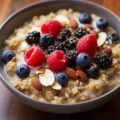Freekeh, pronounced free-kah, may have a whimsical name, but this ancient grain is anything but a joke. Packed with nutrients and boasting a host of health benefits, freekeh is rapidly gaining popularity among health enthusiasts. In this article, we’ll delve into what freekeh is, its nutritional profile, health benefits, and how you can incorporate it into your diet.
What is Freekeh?
Freekeh is a type of ancient grain made from green durum wheat that is harvested while still young. The grains are then roasted, which gives freekeh its unique, slightly smoky flavor. Originating from the Middle East, this grain has been a staple in diets for centuries and is now making a comeback in modern kitchens worldwide.
Nutritional Profile of Freekeh
Freekeh is a nutritional powerhouse. Here are some key nutrients found in a typical serving of freekeh:
- Protein: Freekeh contains about 8 grams of protein per serving, making it an excellent source of plant-based protein.
- Fiber: With up to 4 times the fiber of brown rice, freekeh is great for digestive health.
- Vitamins and Minerals: This grain is rich in vitamins and minerals, including iron, calcium, and zinc.
- Low Glycemic Index: Freekeh has a low glycemic index, which helps in maintaining stable blood sugar levels.
Health Benefits of Freekeh
Incorporating freekeh into your diet can offer numerous health benefits. Here are some of the most notable ones:
- Weight Management: The high fiber content in freekeh can help you feel full longer, aiding in weight management.
- Digestive Health: The fiber helps promote healthy digestion and can prevent constipation.
- Heart Health: Freekeh is low in fat and high in fiber, which can contribute to better heart health.
- Blood Sugar Control: Its low glycemic index makes it a great choice for people with diabetes.
- Rich in Antioxidants: Freekeh contains antioxidants that can help fight inflammation and boost overall health.
How to Cook Freekeh
Cooking freekeh is straightforward and similar to cooking other grains. Here’s a basic method to prepare it:
- Rinse 1 cup of freekeh under cold water.
- In a pot, add the rinsed freekeh to 2 1/2 cups of water or broth.
- Bring to a boil, then reduce the heat to low and simmer for about 20-25 minutes, or until the grains are tender.
- Drain any excess liquid and fluff the freekeh with a fork before serving.
You can use cooked freekeh as a base for salads, soups, or as a side dish. It pairs well with a variety of ingredients, making it a versatile addition to your culinary repertoire.
Delicious Freekeh Recipes
Here are a few simple and delicious ways to incorporate freekeh into your meals:
- Freekeh Salad: Mix cooked freekeh with chopped vegetables, herbs, and a lemon vinaigrette for a refreshing salad.
- Freekeh Porridge: Cook freekeh with milk and sweeten with honey and fruits for a nutritious breakfast.
- Stuffed Peppers: Use freekeh as a filling for stuffed peppers, along with vegetables and spices.
- Freekeh Soup: Add cooked freekeh to your favorite vegetable or chicken soup for added texture and nutrients.
FAQ
Is freekeh gluten-free?
No, freekeh is made from wheat and therefore contains gluten. It is not suitable for those with celiac disease or gluten intolerance.
Where can I buy freekeh?
Freekeh is available in most health food stores, specialty grocery stores, and online retailers. Look for it in the grain or international foods section.
How should I store freekeh?
Uncooked freekeh should be stored in an airtight container in a cool, dry place. Cooked freekeh can be refrigerated for up to 5 days.
Can I use freekeh in baking?
Yes, you can use freekeh in baking. Freekeh flour can be used in place of whole wheat flour in many recipes, adding a unique flavor and nutritional boost.
Is freekeh suitable for vegans?
Yes, freekeh is a plant-based food and is suitable for vegans and vegetarians.









